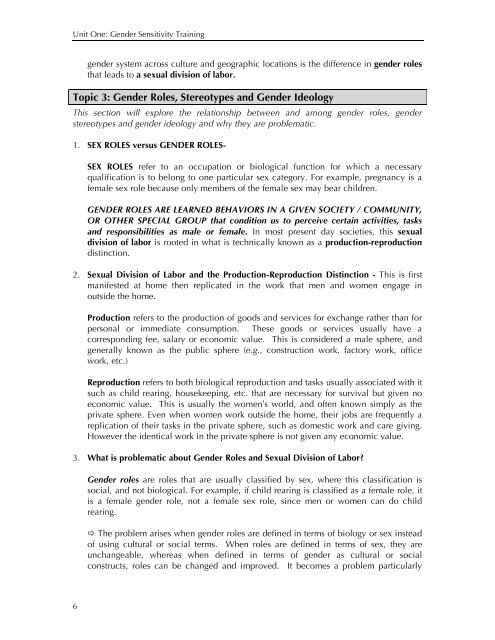Training Manual on Gender Sensitivity and CEDAW
Training Manual on Gender Sensitivity and CEDAW
Training Manual on Gender Sensitivity and CEDAW
You also want an ePaper? Increase the reach of your titles
YUMPU automatically turns print PDFs into web optimized ePapers that Google loves.
Unit One: <strong>Gender</strong> <strong>Sensitivity</strong> <str<strong>on</strong>g>Training</str<strong>on</strong>g><br />
gender system across culture <strong>and</strong> geographic locati<strong>on</strong>s is the difference in gender roles<br />
that leads to a sexual divisi<strong>on</strong> of labor.<br />
Topic 3: <strong>Gender</strong> Roles, Stereotypes <strong>and</strong> <strong>Gender</strong> Ideology<br />
This secti<strong>on</strong> will explore the relati<strong>on</strong>ship between <strong>and</strong> am<strong>on</strong>g gender roles, gender<br />
stereotypes <strong>and</strong> gender ideology <strong>and</strong> why they are problematic.<br />
1. SEX ROLES versus GENDER ROLES-<br />
SEX ROLES refer to an occupati<strong>on</strong> or biological functi<strong>on</strong> for which a necessary<br />
qualificati<strong>on</strong> is to bel<strong>on</strong>g to <strong>on</strong>e particular sex category. For example, pregnancy is a<br />
female sex role because <strong>on</strong>ly members of the female sex may bear children.<br />
GENDER ROLES ARE LEARNED BEHAVIORS IN A GIVEN SOCIETY / COMMUNITY,<br />
OR OTHER SPECIAL GROUP that c<strong>on</strong>diti<strong>on</strong> us to perceive certain activities, tasks<br />
<strong>and</strong> resp<strong>on</strong>sibilities as male or female. In most present day societies, this sexual<br />
divisi<strong>on</strong> of labor is rooted in what is technically known as a producti<strong>on</strong>-reproducti<strong>on</strong><br />
distincti<strong>on</strong>.<br />
2. Sexual Divisi<strong>on</strong> of Labor <strong>and</strong> the Producti<strong>on</strong>-Reproducti<strong>on</strong> Distincti<strong>on</strong> - This is first<br />
manifested at home then replicated in the work that men <strong>and</strong> women engage in<br />
outside the home.<br />
Producti<strong>on</strong> refers to the producti<strong>on</strong> of goods <strong>and</strong> services for exchange rather than for<br />
pers<strong>on</strong>al or immediate c<strong>on</strong>sumpti<strong>on</strong>. These goods or services usually have a<br />
corresp<strong>on</strong>ding fee, salary or ec<strong>on</strong>omic value. This is c<strong>on</strong>sidered a male sphere, <strong>and</strong><br />
generally known as the public sphere (e.g., c<strong>on</strong>structi<strong>on</strong> work, factory work, office<br />
work, etc.)<br />
Reproducti<strong>on</strong> refers to both biological reproducti<strong>on</strong> <strong>and</strong> tasks usually associated with it<br />
such as child rearing, housekeeping, etc. that are necessary for survival but given no<br />
ec<strong>on</strong>omic value. This is usually the women’s world, <strong>and</strong> often known simply as the<br />
private sphere. Even when women work outside the home, their jobs are frequently a<br />
replicati<strong>on</strong> of their tasks in the private sphere, such as domestic work <strong>and</strong> care giving.<br />
However the identical work in the private sphere is not given any ec<strong>on</strong>omic value.<br />
3. What is problematic about <strong>Gender</strong> Roles <strong>and</strong> Sexual Divisi<strong>on</strong> of Labor<br />
<strong>Gender</strong> roles are roles that are usually classified by sex, where this classificati<strong>on</strong> is<br />
social, <strong>and</strong> not biological. For example, if child rearing is classified as a female role, it<br />
is a female gender role, not a female sex role, since men or women can do child<br />
rearing.<br />
The problem arises when gender roles are defined in terms of biology or sex instead<br />
of using cultural or social terms. When roles are defined in terms of sex, they are<br />
unchangeable, whereas when defined in terms of gender as cultural or social<br />
c<strong>on</strong>structs, roles can be changed <strong>and</strong> improved. It becomes a problem particularly<br />
6

















